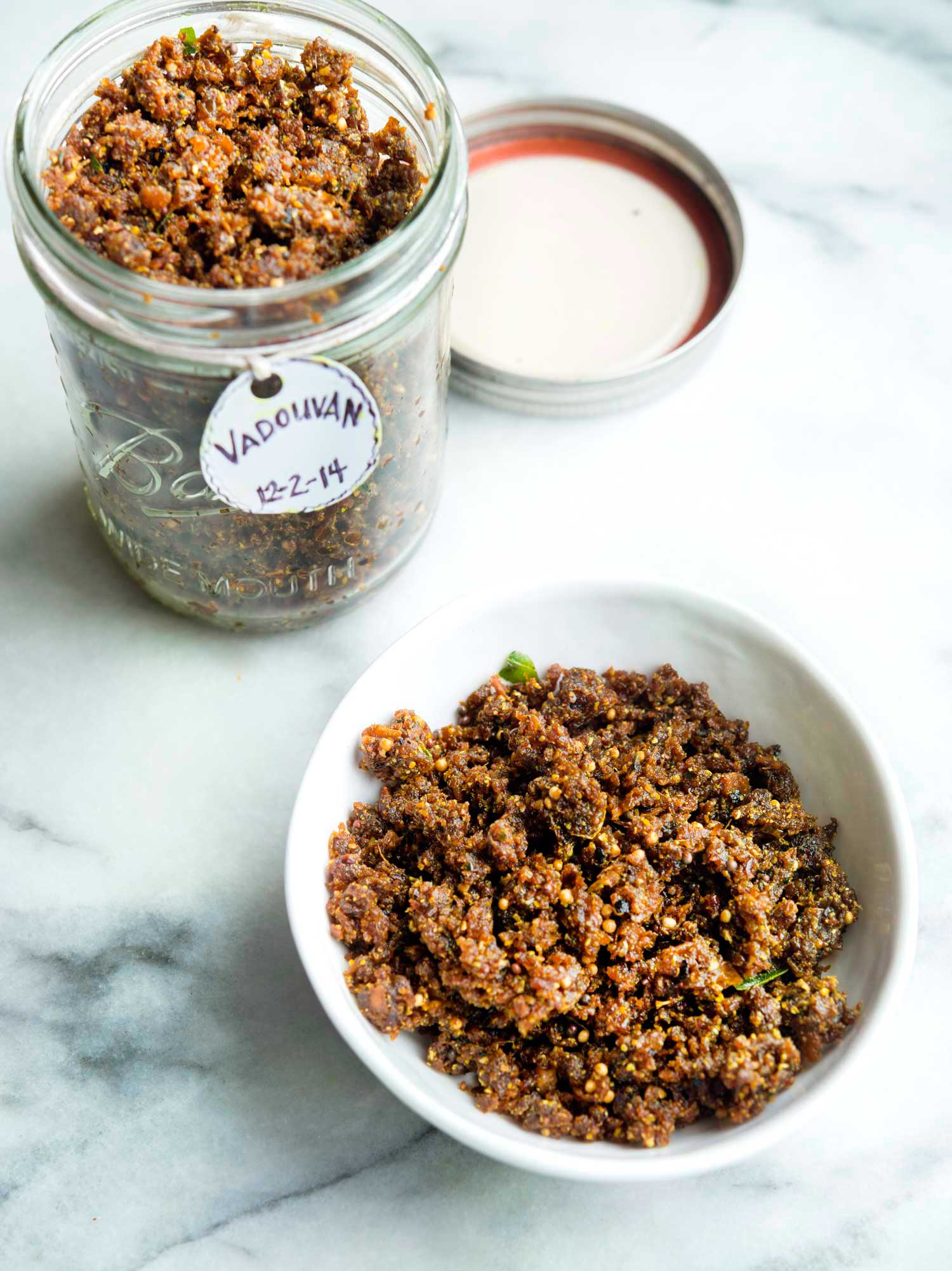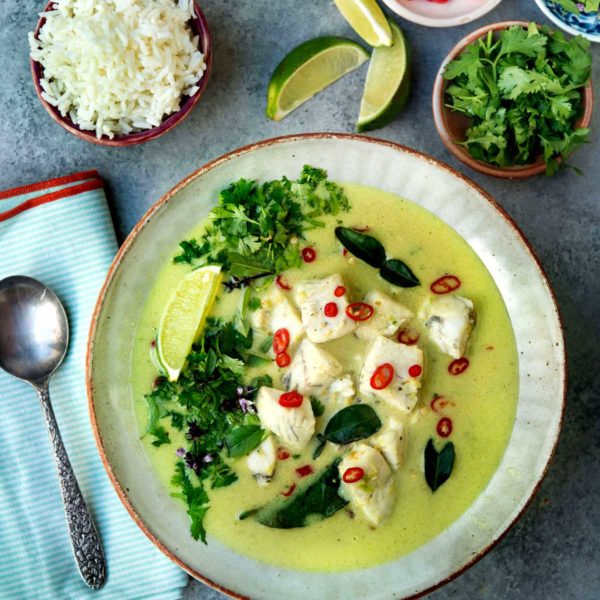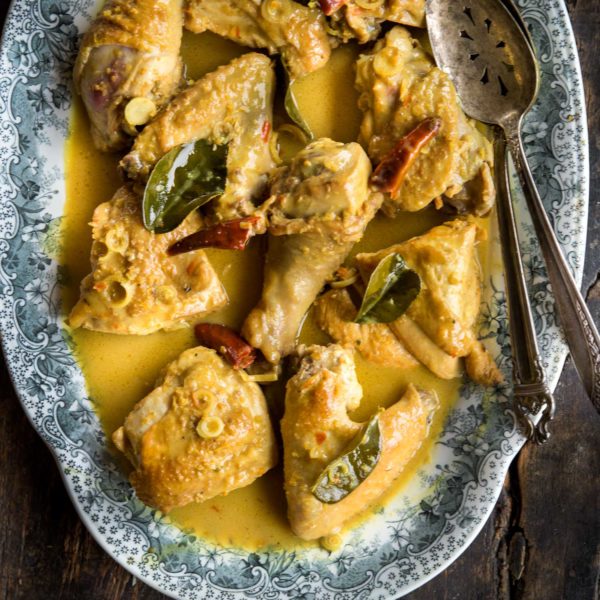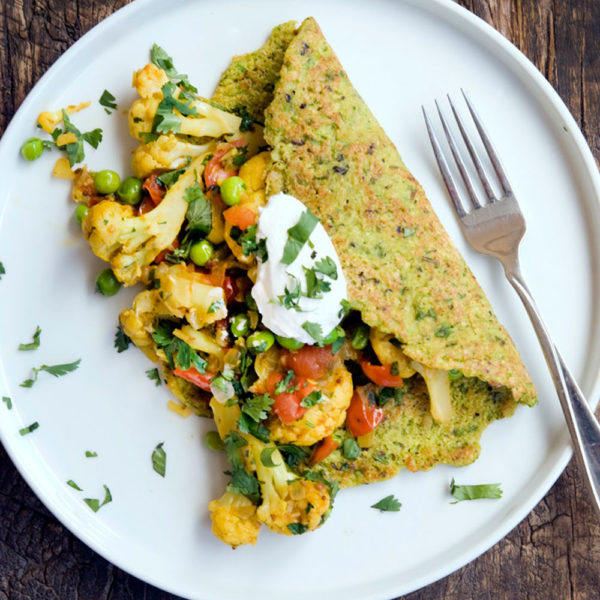Received a new cookbook for my birthday back in November (one can never have too many cookbooks; for me, cookbooks are better than shoes). This one. After perusing it, I bookmarked several recipes; the vadouvan spice mix was at the top of my list.
Vadouvan appears to be en vogue at the moment. A few words about vadouvan… Vadouvan is a French-ified curry spice blend. The French influence comes from the addition of shallots and garlic. I’ve ordered vadouvan online from here and here, though was curious to make it myself.
Making vadouvan is a bit of a time commitment, not to mention that it involves a lengthy list of ingredients. But once I set my mind on something, there’s no turning back. So, not long thereafter on my day off, I found myself driving all over town in a frenzy, on a hunt for spices. One spice shop, one Indian grocery store, and one additional trip to the grocery store to pick up what I couldn’t find at the other two — I managed to track down everything I needed (and a few extra things, why not?).
There’s lots of chopping, stirring, simmering involved when it comes to vadouvan. And after all that, you’re still not quite done. The mixture then needs to dry — in a dehydrator or in the oven at a low temperature — for several hours.
Is it worth it?
Absolutely. While time consuming, there’s no comparison between homemade and store-bought vadouvan. Not even close.
Vadouvan is versatile. Sprinkle it on just about anything from green salads, to grilled vegetables, to fish, to poultry, to pork, to lamb, to eggs, to popcorn, to rice and grains…
You can’t go wrong with vadouvan brown butter…
Or vadouvan compound butter…
Homemade Vadouvan Spice Blend
Slightly Adapted from Mourad New Moroccan
makes 3 1/2 cups
Mourad’s measurements are very exact (I didn’t want to mess too much with his measurements and screw this up, but I can’t say I was as exact as Mourad. Notwithstanding, in the end, the vadouvan was excellent).
1/2 cup grapeseed or canola (used olive oil)
6 1/2 cups finely chopped shallot
1 cup sliced garlic
5 tablespoons finely chopped onion
1/2 cup plus 2 tablespoons finely chopped fresh ginger
13 small fresh curry leaves, stack and slice cross-wise into thin slivers
6 1-inch pieces fresh turmeric grated on a microplane or 1 1/2 teaspoons ground turmeric
1 tablespoon plus 2 1/4 teaspoons Madras curry powder
2 3/4 teaspoons kosher salt
2 1/8 teaspoons yellow mustard seeds
1 1/8 teaspoons brown mustard seeds
2 3/4 teaspoon ground cumin
1 tablespoon plus 3/4 teaspoon ground coriander
1 1/2 teaspoons ground fenugreek or 2 teaspoons fenugreek seeds, crushed
1 1/2 teaspoons Marash pepper (I couldn’t find, substituted Aleppo pepper)
1 3/4 teaspoon coriander seeds
3/4 teaspoon ground green cardamaom
1/2 teaspoon freshly grated nutmeg
1/4 teaspoon ground cloves
1/4 teaspoon cayenne
Note: All whole spices were toasted and then ground. To toast the spices, place a frying pan with the spices over medium heat, and stir/toss the spices. After a minute, they will start to release their aroma and begin to crackle. Continue to toast your spices a few more minutes, tossing and watching closely. Make sure they don’t burn. The spices should smell nutty and sweet. Grind in a spice grinder until you achieve a fine powder.
Combine all the dry spices in a bowl and set aside.
Set a large pot over medium-low heat and pour in the grapeseed (or canola or olive oil). Add the shallots, garlic, onion, and ginger. Cook for 20 minutes or until the liquid has come out of the onions. Increase the heat to medium and cook for 1 1/4 hours, stirring often, adjusting the heat to prevent burning, until all the moisture has evaporated.
Increase the heat to medium-high and continue cooking the onion mixture, stirring often, until it is richly caramelized. Add the fresh turmeric (if using) and curry leaves, and stir to combine. Stir in the dry spices and cook for about 2 minutes, until fragrant.
Spread the mixture in thin layers on dehydrator racks. Heat the dehydrator to 125F. Place the racks in the dehydrator and check every 1 1/2 hours, turning the mixture with a spatula and rotating the trays such that the mixture drys evenly. The drying process will take 4 to 7 hours (mine took about 6 hours).
The finished vadouvan will be dark caramel brown in color and will still have a bit of moisture from the fat.
Store in the refrigerator up to one month or in the freezer for three months.













5 comments
Sita cultural centre
Hello,
We are a French Tamil cultural centre of Pondicherry and we are currently writting an article about Vadouvan ! We would like to ask you if we could use your first picture to illustrate it ? We would of course put the name of the photographer on it and send you the article once ready to have you agreement
Best regards from all SITA team
wildgreensandsardines@gmail.com
Sure, you can use my photo. Look forward to seeing the finished article.
Best,
Linda
Theresa
I would like to see the article too
Anu Pillai
The French vadouvan is based on the vadagam from when they occupied Pondicherry, the Tamil speaking parts of the south of India. Shallots and garlic are very much a part of vadagam or vadouvan as it is called in the southern parts of India. It’s not a French addition to an Indian dish. South Indians, especially use a lot of shallots and garlic in their recipe. The cardamom, cloves, and nutmeg are not typical to a vadgam recipe. It’s kind of mixing two very disparate, distinct flavors from the north and south into a spice blend.
The vadagam is typically a spice blend that is ground into a coarse thick paste and sun-dried until dry. It’s then used as a seasoning or eaten fried as a side with rice porridge (kanji as rice porridge is referred to in Tamil).
wildgreensandsardines@gmail.com
Hi Anu, Thanks so much for providing this information (I’m going to add this to the post). Do you have a vadagam version that you make, that you wouldn’t mind sharing? I would love to give it a try (along with the kanji). Much appreciated! Linda